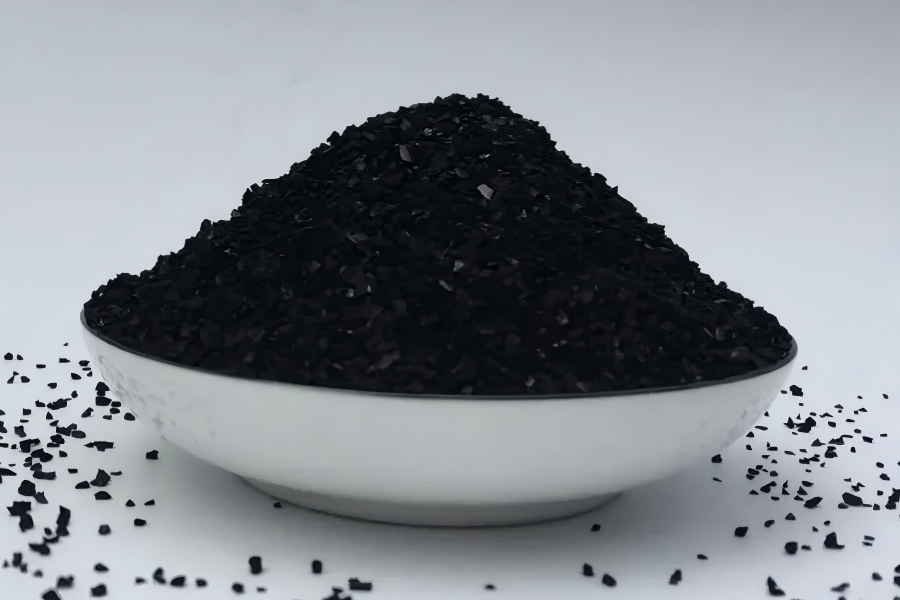
Regeneration of activated carbon
Regeneration Principle:
The regeneration of activated carbon refers to the process of removing adsorbates from its micropores and restoring adsorption capacity through physical or chemical methods without compromising its original structure. During the adsorption process, activated carbon simultaneously adsorbs both adsorbates and solvents. Due to varying affinity levels, equilibrium is achieved after a certain period of adsorption.
Activated carbon regeneration requires disrupting this equilibrium through specific methods, primarily based on the following principles:
① Altering the chemical properties of adsorbates;
② Extracting with solvents that exhibit strong affinity for adsorbates;
③ Replacing adsorbates with substances having greater affinity for activated carbon, followed by desorption to regenerate the carbon;
④ Adjusting equilibrium conditions through external heating or temperature elevation;
⑤ Regenerating by reducing solute concentration (or pressure) in the solvent;
⑥ Decomposing or oxidizing adsorbates (organic compounds) to remove them.
Regeneration Methods:
(1) Thermal Regeneration Method The thermal regeneration method is the most mature activated carbon regeneration technique. During the regeneration process of activated carbon treated with organic wastewater, it generally involves three stages based on changes in organic matter at different heating temperatures: drying, high-temperature carbonization, and activation. In the drying stage, volatile components such as moisture are removed from the activated carbon. The high-temperature carbonization stage vaporizes and desorbs some adsorbed organic compounds while decomposing others into small molecules, leaving residual components within the carbon pores as fixed carbon.
The activation stage introduces gases like CO2, CO, or water vapor to clean the micro-pores inside the activated carbon, restoring its adsorption capacity. The core of the regeneration process lies in the activation stage. Although the thermal regeneration method offers high efficiency and short processing time with broad application scope, significant carbon loss (up to 5%-10%) occurs during regeneration. Additionally, the mechanical strength of regenerated carbon decreases, leading to reduced adsorption efficiency. Repeated regeneration cycles may ultimately result in complete loss of adsorption performance.
(2) Biological Regeneration Method The biological regeneration method utilizes microbial metabolism to oxidize and degrade pollutants adsorbed on activated carbon. Given that activated carbon pores typically measure only a few nanometers in diameter, microorganisms struggle to penetrate these microscopic spaces. Instead, microbial enzymes flow into the extracellular environment, where they are adsorbed by the activated carbon to form enzymatic centers on its surface.
These centers then decompose pollutants, achieving regeneration. While biological methods require relatively lower initial and operational costs, they demand extended regeneration periods and are significantly affected by water quality and temperature. Additionally, microbial treatment exhibits strong selectivity in pollutant removal, often failing to completely break down all organic matter into CO2 and H2O. Intermediate products remain trapped in the micropores, leading to a noticeable decline in regeneration efficiency after multiple cycles.
(3) Wet Oxidation Regeneration Method The wet oxidation regeneration method is a treatment approach that utilizes oxygen or air as oxidizing agents under high-temperature and high-pressure conditions to decompose adsorbed organic compounds in liquid phase into smaller molecular substances. This method features simple operation, minimal impact on adsorption capacity, and low carbon loss rate, making it particularly suitable for treating highly toxic and biologically refractory organic substances.
The above are all traditional regeneration methods. Generally, the traditional activated carbon regeneration methods also have the following common shortcomings:
① Large loss of activated carbon;
② The adsorption capacity will be significantly reduced after regeneration;
③ The exhaust gas generated during regeneration will cause secondary pollution.

With the development of science and technology, some new regeneration methods have emerged:
4) Microwave Radiation Regeneration Method The microwave radiation regeneration method is an activated carbon regeneration technique developed from the principles of thermal regeneration. Most adsorbed substances in activated carbon are highly polar molecules, which exhibit stronger absorption capacity than the material itself. This enables effective regeneration through pyrolysis. Polar molecules become polarized under microwave irradiation, generating intense heat through collisions and friction that converts microwave energy into thermal energy.
The adsorbed water and organic molecules evaporate and undergo carbonization when heated, reopening the pores to restore adsorption capacity. Simultaneously, the activated carbon absorbs microwave radiation, causing excessive temperature rise that triggers combustion. This process leads to partial carbon loss and expansion of pore dimensions.
(5) Supercritical Fluid Regeneration Method The advantages of supercritical fluid (SCF) include high density, strong solubility, rapid mass transfer, excellent diffusion properties, and low surface tension. Organic substances adsorbed can be easily dissolved in SCF. By adjusting temperature and pressure, organic matter can be effectively separated from SCF, achieving the purpose of activated carbon regeneration.
(6) Electrochemical Regeneration Method The electrochemical regeneration method represents a novel activated carbon regeneration technique that has seen significant research activity in recent years. This process involves placing adsorbed saturated activated carbon between two electrodes, introducing an electrolyte solution, and applying a direct current electric field. Under the electric field’s influence, the carbon becomes polarized with one end serving as the anode and the other as the cathode, forming a micro-electrolytic cell.
This configuration enables simultaneous reduction and oxidation reactions, effectively decomposing most pollutants adsorbed on the carbon while partially desorbing residual contaminants. The method features simple operation, high efficiency, low energy consumption, and broad applicability across various treatment scenarios.
Our company provides high quality and stable products, including reverse osmosis system, sludge dewatering machine, mechanical grille, dosing device, electrical control cabinet, etc., our professionals will provide you with installation, commissioning, operation, and follow-up maintenance services to help you solve problems!
Yixing Shenghe Environmental Protection Co., Ltd.

IPv6 network supported